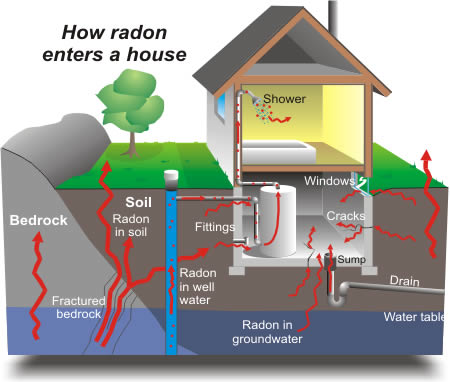Ten Myths about Radon
Radon is a radioactive gas that occurs n aturally in the soil and often leaks into lower levels of homes. Exposure to radon is the second leading cause of lung cancer, behind smoking, and leads to 21,000 lung cancer deaths annually. Because you aren’t able to see, smell or taste radon gas, it’s important to test the air in your home and fix any problems you find. Many people don’t believe their home is in area with radon, one of the common myths about radon.
aturally in the soil and often leaks into lower levels of homes. Exposure to radon is the second leading cause of lung cancer, behind smoking, and leads to 21,000 lung cancer deaths annually. Because you aren’t able to see, smell or taste radon gas, it’s important to test the air in your home and fix any problems you find. Many people don’t believe their home is in area with radon, one of the common myths about radon.
EPA’s Common Myths about Radon
Recently the EPA has reported ten common myths people have about radon, which follow.
1. Myth: Scientists are not sure that radon really is a problem.
Fact: While scientists are not certain of the exact number of deaths due to radon, the major health organizations, including the Center for Disease Control (CDC), American Medical Association (AMA), and American Lung Association all agree that radon causes thousands of otherwise preventable lung cancer deaths annually, especially among smokers.
2. Myth: Radon testing is difficult and expensive.
Fact: Testing for radon is easy and inexpensive, either by testing your home yourself or hiring a qualified radon testing professional. It has been shown that long-term testing kits, for at least 90 days, are more accurate than short-term kits.
3. Myth: It is impossible to fix a home with radon problems.
Fact: Many homes have already been successfully fixed. The cost radon problems can be fixed by qualified radon mitigation contracts for about the same cost as other home repairs.
4. Myth: Radon affects only certain types of homes.
Fact: Radon can affect any type of home: old or new, drafty or insulated, and with or without basements. The primary factors that affect radon levels in homes are local soils, construction materials, and building methods.
5. Myth: Radon occurs in only certain areas of the country.
Fact: Radon levels do tend to be higher in certain areas, but they have occurred in all 50 states. The only way to be certain your house does not contain radon is to test it.
6. Myth: If my neighbor has/doesn’t have radon, it must be the same for me.
Fact: This is not true. Radon levels do vary greatly between homes. The only way to be sure your home does not have a radon problem is to test it.
7. Myth: Everyone should also test their water for radon.
Fact: Radon can get into homes through ground water, but it is most important to test the air first. While radon gets into some homes through water, it is important to first test the air in the home for radon. If your water comes from a public water supply that uses ground water, call your water supplier. If high radon levels are found and the home has a private well, call the Safe Drinking Water Hotline at (800) 426-4791 for information on testing your water.
8. Myth: Selling a home with radon problems is difficult.
Fact: As long as the radon problems have been fixed, there is no problem selling a home. As a matter of fact, the added protection could be turned into a selling point.
9. Myth: It doesn’t make sense to check my home for radon because I’ve already lived here a long time.
Fact: Even if you’ve lived with an elevated radon level for many years, correcting it now will still reduce your risk for lung cancer.
10. Myth: Short-term tests don’t help determine whether or not to correct radon problems.
Fact: Short-term tests can be used to determine whether or not to reduce a high radon levels. If the short-term test result is close to pCi/L (pico Curies per Liter), it is difficult to determine whether the radon level is above or below that average throughout the years. Ideally, the level should be 2 pCi/L or lower to be safe.
For more information, refer to the EPA’s A Citizen’s Guide to Radon.
What If My Home Needs Radon Testing or Repair?
If you’ve tested your home and had a high radon level or want a professional in radon mitigation to test and/or repair your radon problems, contact the experts at Ameriserv Radon Mitigation of Iowa.
Don’t put you and your family at an unnecessary risk for lung cancer!
 Our Response to COVID-19
Our Response to COVID-19 
